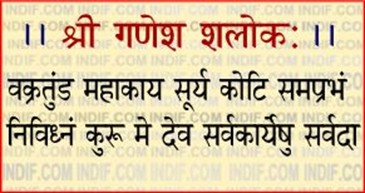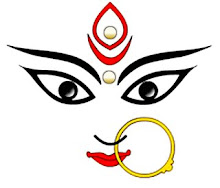Celebrating the Birthday of Lord Ganesha
 |
| Lord Ganesha - God of Wisdom |
II Shri Ganesha Shloka II
II श्री गणेश शलोक II
vakratu.nDa mahaakaaya koTisuuryasamaprabha |
nirvighnaM kuru me deva sarvakaaryeshhu sarvadaa ||
II Meaning of Shree Ganesha Shloka II
O God Ganesha [large bodied with a large belly], radiant as millions of Suns, Please, remove obstacles in all of my tasks, all the time
Ganesh Chaturthi, or Vinayaka Chaturthi, is the birthday of Lord Ganesha, the God of wisdom, prosperity and auspiciousness.
Ganesh Chaturthi 2011 date is September 1, Thursday. Ganesha is today worshipped around the world and the Elephant-faced Hindu god is one of the most popular deities associated with Hinduism. Like symbol ‘Om’, Ganesha is slowly becoming the face of Hindu religion. The Ganapati Festival ends with the immersion [Visarjan] of the idol on Ananta Chaturdasi day - September 11, 2011.
Ganesh Chaturthi falls on the fourth day after new moon in the Hindu month of Bhadrapada [August - Septembe].
 |
Ganesha with Lord Shiva and
GoddessParvati |
Ganesha is the remover of obstacle - Vighneshwara or Vignaraja – and is always invoked when Hindus are beginning a new enterprise. It is believed that Goddess Parvati created Ganesha out of clay and breathed life into him. Letting him stand guard at the door, Goddess Parvati went to have her bath. When her husband, Lord Shiva returned, the child who had never seen him stopped him. Ganesha did not allow Shiva to enter and finally an enraged Shiva severed the head of the child. Goddess Parvati returned to find her son dead and was distraught and asked Shiva to revive him. Shiva cut off the head of an elephant and fixed it on the body of Ganesha and giving birth to elephant-headed Ganesha.
 |
| The Elephant-Headed Ganesha |
There is also a story behind the symbolic snake, rat and the singular tusk. During one of his birthdays, His mother, Parvati, cooked for him twenty-one types of delicious food and a lot of sweet porridge. Ganesha ate so much that even his big belly could not contain it. Mounting his little mouse, he embarked on his nightly rounds. His mouse suddenly stumbled upon seeing a huge snake. To adjust His belly, Ganesha put the snake on as a belt around his stomach. All of a sudden, he heard laughter emanating form the sky.
 |
Lord Gansha Riding His
Vehicle-Mouse |
 |
| Lord Ganesha with the Broken Tusk |
He looked up and saw the moon mocking him. Ganesha infuriated, broke off one of his tusks and hurled it at the moon. Parvati, seeing this, immediately cursed the moon that whoever looks at it on Ganesh Chaturthi will be accused of a wrong doing. The symbology behind the mouse and snake and Ganesha's big belly and its relationship to the moon on his birthday is highly philosophic. The whole cosmos is known to be the belly of Ganesha. Parvati is the primordial energy. The seven realms above, seven realms below and seven oceans, are inside the cosmic belly of Ganesha, held together by the cosmic energy [kundalini] symbolized as a huge snake which Ganesha ties around Him. The mouse is nothing but our ego. Ganesha, using the mouse as a vehicle, exemplifies the need to control our ego. One who has controlled the ego has Ganesha consciousness or God-consciousness.
 |
| Ganesh Chaturthi |
Ganesh Chaturthi or Vinayaka Chaturthi is one of the most colorful and widely celebrated festivals in India. Large number of people observe Ganesha Chaturthi poojas at home. Ganesha puja on the Chaturthi day is usually performed at noon.
The priest, usually clad in red silk dhoti and shawl, then symbolically invokes life into the statue by chanting manras. This ritual is the Pranapratishhtha. After this the ritual called as Shhodashopachara [16 ways of paying tribute] follows. Coconut, jaggery, 21 modakas, 21 durva [trefoil] blades of grass and red flowers are offered. The statue is anointed with red unguent, typically made of kumkum and Sandalwood paste . Throughout the ceremony, Vedic hymns from the Rig Veda, the Ganapati Atharva Shirsha Upanishad, and the Ganesha stotra from the Narada Purana are chanted.
The number 21 signifies - the five organs of perception, five organs of action, five vital airs [pranas], five elements, and the mind. One must perform the puja with a clean body and clean mind. What is more important is devotion not the ritual.
Lord Ganesh's favorite sweet is the Modakam [Kozhukattais]. These are like sweet steamed rice [flour] dumplings. It is customary to make these during this festival. They are very delicate and tender, in a shape of Modakam. In the north, many Pedhas too are shaped like this and sold at this time in many Indian sweet stores. It does take practice to make this delicate dessert. The inside is filled with a coconut and jaggery filling.
The Myth Behind Lord Ganesha
The primary problem of human beings is that we cannot forsee things that Lord Ganesha, the elephant-head Gods' speciality, is that he can foresee, both seen and unseen obstacles.
 |
| Large-Bellied God - Lord Ganesha |
It is a known fact that the elephant is an animal that can process unra-sound[sound below 20 cycles per second]. This range is outside of the normal audible spectrum of humans. The elephant and some other animals too are capable of this detection You will find that this was evident during the Tsunami of 2004, it was recorded that most animals in the coastal regions headed for the hills in advance of the wave, as they could seen the unseen.
The form of Lord Ganesha is depicted as an elephant with Big ears to symbolize that. His prominent ears also denote that He listens to every single prayer of his devotees.
Mytho-historically, Lord Ganesha, although large-bellied and slow like an elephant, is known for His inelligence, grasping situations in lightening speed and succeed with minimal effort. A fine example of this is seen wherein Narada mischeviously testing the two sons of Lord Shiva and Goddess Parvathi [Ganesh and Muruga].
 |
| Narada with the Gift of Omnipotence-The Mango |
Narada had produced a Mango, infused with powers of "Omnipotence or Unlimited Power".
A contest was decided upon to determine who of Lord Ganesha and Muruga should receive the gift of "Omnipotence". Narada approached the Divine Supreme family in their Abode in Kailash and said the Mango was a gift which should go to only one person. It was decided that the brothers would race round the Universe and whoever came back first, would be the recipient of the Gift of Omnipotence. While Lord Muruga, perched on His peacock went round the Universe with great strength and speed, Lord Ganesha had only His little mouse, He instantly grasped the full reality of the situation and stood up and walked round His parents, Shiva and Parvati. Then Lord Ganesha bowed before them and requested the price. Lord Muruga, who had just in that time, circled the Universe, returned to see Ganesha completing His bow.
 |
Ganesha Requesting the Mango from
His Parents |
"What do you mean by requesting the Mango?", Lord Shiva asked of Ganesha. Ganesha responded with a smile, " Is it not true that my Parents are the Universe itself? Within Lord Shiva and Goddess Parvati exists all that was and ever will be".
The parents could not deny Ganesha and He was gifted he Divine Mango, infused with Omnipotence.
This mythology demonstrates the power embodied in Lord Ganesha. Lord Ganesha can bless you with intellligence and the ability to be strategic.
 |
| The Fearless -Lord Ganesha |
Ganesha is known to have braved even to fight His own father Lord Shiva He is fearless. The prime emotion that leads to all types of confusions, conflicts and failure is fear and Lord Ganesha removes Fear.
Lord Ganesha balances the Muladhara Chakra which represents both extremes of the fear factor. He stimulates intelligence, enhances your problem solving skills, stabilizes your emotions, removes obstacles and guides you to the path of success.
Muladhara represents the Element Earth, therefore Clay Ganesha. Statues and idols are made in clay and then rituals are performed to absorb your Karma into the statues. They are then put into the sea where they dissolve. This is a very powerful tantric ritual designed by the ancient scientists and Yogis.
Since Lord Ganesh is the incarnation of the collective qualities inevitable to make a human being happy and successful, He is always ready to give it to anyone who asks Him for it.
 |
| Dancing Lord Ganesha |
It is a known fact that Lord Ganesha gives His blessings equally to both - intellectuals and the not so intellectual ones.
A Mantra for Ganesha
" Om GAM Ganapataye Namaha"
 |
| Lord Ganesha - The "OM" Symbol |
When you are in "GAM"...you are in connection with ultra-sound and everything happens effortlessly. You get the capacity to do things without much effort. Ganesha is an Effortless God . When His brother Muruga mounted the Peacock and went round the world in the Mango competition, Ganesha won effortlessly with Wisdom.
Any offering done on Ganesha Chaturthi eliminates problems either foreseen or unforeseen. The Fourth Moon possesses special powers to remove stubborn Karmic effects in many areas in our life. The nauture of the Fourh Moon is that of "destroying" , so Lord Ganesha utilises this day to intelligently desroy all obstacles that come our way.
The Moon is the ruler of the Mind, and the Moon is not efficient enough on the Fourth Moon; so one should perform actions that will strengthen the positive mind and intelligence. Since all obstacles are created by the wrong mind, it is best that we all turn our mind to Lord Ganesha on His Birthday.
 |
Lord Ganesha - The "Sankata Harana"
and "Vighna Nivarana" God |
He is known to one and all as "Vighna Nivarana" or "Remover of Hurdles" and "Sankata Harana" or "Remover of Sorrows".
Lord Ganesha, the Chief God for Knowledge and Wisdom, rules over the Planet Ketu, which is known as the first Planet, and also known to be the most powerful Planet among the Nine Planets. Ketu governs Wisdom or "Jnana".
Wisdom no doubt comes after proper understanding of your experiences, and not simply with the accumulation of knowledge. Errors in the course of action could be wasted by dwelling on them, but Wisdom is learning the lesson in the mistake. Ketu gives you this Wisdom and helps you to work through your Karmas intelligently.
Sri Chandrasekarendra Saraswathy Swamigal, the former Sankaracharya of Kanchi Mutt has cited " that Ganesha re-invents Himself and comes down as a new incarnation in every Yuga according to the thought patterns of the humans that prevail during that particular epoch. In this Kali Yuga, it is he "Naramuga Ganesha" who is the most powerful, because He is the Ganesha for this Age!
Ganesh Chaturthi Celebrations
 |
The Ganesh Chatruthi Celebrations
and Procession |
The festival of Ganesh Chaturthi is celebrated in the states of Maharashtra, Tamil Nadu, Karnataka and Andhra Pradesh and many other parts of India. Started by Chatrapati Shivaji Maharaja, the great Maratha ruler, to promote culture and nationalism, the festival was revived by Lokmanya Tilak [freedom fighter] to spread the message of freedom struggle and to defy the British who had banned public assemblies. The festival gave the Indians a feeling of unity and revived their patriotic spirit and faith. This public festival formed the background for political leaders who delivered speeches to inspire people against the Western rule. The festival is so popular that the preparations begin months in advance.
 |
Lok manya Tilak-
The Freedom Fighter |
Tilak also sought to have all the immersions take place on the tenth and final day. Since then this festival just like the many other Indian festivals that are celebrated with pomp and show, is an extraordinary testimony to the public place of religion in Indian life.
 |
Artists giving the Final Touches
to Ganesha Idols |
 |
| Artists in the making of Ganesha Idols |
Ganesha statues are installed in street corners and in homes, and elaborate arrangements are made for lighting, decoration, mirrors and the most common of flowers. Pujas are performed daily. The artists who make the idols of Ganesha compete with each other to make bigger and more magnificent and elegant idols. The relevantly larger ones are anything from 10 meters to 30 meters in height. These statues are then carried on decorated floats to be immersed in the sea after one, three, five, seven and ten days. Thousands of processions converge on the beaches to immerse the holy idols in the sea. This procession and immersion is accompanied by drum-beats, devotional songs and dancing.
 |
"Visarjan" - Immersion in the Sea on
Ananta Chaturdasi Day |
 |
| Chanting - "Ganapati Bappa Morya" |
The Ganapati Festival ends with the immersion [Visarjan] of the idol on Ananta Chaturdasi day. Here is the Video of this grand finale to the Ganesh Chaturthi Festival:
http://www.youtube.com/watch_popup?v=xudHgZB8noA&vq=small#t=182
It is still forbidden to look at the moon on that day as the moon had laughed at Ganesha when he fell from his vehicle, the rat. With the immersion of the idol amidst the chanting of "Ganesh Maharaj Ki Jai!" [Hail Lord Ganesh]. The festival ends with pleas to Ganesha to return the next year with chants of.......
"Ganpati bappa morya, pudcha varshi laukar ya"- meaning, "Hail Lord Ganesh, return again soon next year".
" HAPPY GANESH CHATURTHI"












































No comments:
Post a Comment